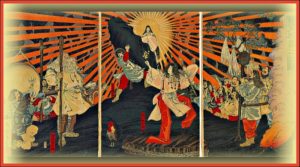
Amaterasu in Shinto religion
Amaterasu was known to be the chief deity and the goddess of the sun in Japanese Shinto religion. She was said to be born following the death of her mother Izanami as her father Izanagi cleansed his face; Amaterasu was born from his left eye, her brother Tsukiyomi born from his right and her brother Susano-O born from his nose. Izanagi then gave her a sacred necklace in order to grant her the power over both land and sea and establish her as the chief deity. Our sources for Amaterasu are the two primary sources for the Shinto religion; the Kojiki and the Nihon Shoki, which both show the lineage of Japan leading from Amaterasu to her direct descendants, the Emperors of Japan. These texts were created in order to distinguish the original beliefs of the Japanese people from the arrival of Buddhism and its followers in Japan in the 6th century.
The Kojiki translates to the Record of Ancient Matters and dates to 712CE, making it the original source of the history of Japan. This narrative begins with mythological creation, following with the introduction of all gods and goddesses in the Shinto religion. It then proceeds through Japanese historical legends and culminates with a chronology of the early Imperial line of Japanese emperors. The Nihon Shoki was created in 720CE, around the same time as the Kojiki and follows an almost identical narrative. This particular text is written in Chinese and was created as the first of six collections on the orders of the Imperial Court, in order to compile a collection of the history of their court that could be compared with the Chinese Annals, showing the influence that the Chinese held over Japan at this time. Nihon Shoki translates to the Chronicles of Japan and like the Kojiki, was based on ancient oral traditions of Japanese history.
Amaterasu appears in both of these 8th century texts as the Japanese representation of a Pan-Asiatic solar deity. As such, there are several similarities between Amaterasu, the Korean sun god Haemosu and the Chinese sun goddess Xihe. The most common link between these 3 deities is the existence of a three-legged crow in association with the solar deity; the Japanese Yatagarasu, the Chinese Yangwu and the Korean Samjok-O. Their main difference however, is that only Amaterasu was worshipped as the central deity as the rest were discouraged by the introduction of religions such as Buddhism and Taoism to worship solar deities.
The Kojiki and the Nihon Shoki both show Amaterasu as the chief deity of the Shinto religion and as the ruler of both land and sea, while her brother Tsukiyomi ruled over the moon and her brother Susano-O was given the power over the oceans and the storms. The genders of Amaterasu and Tsukiyomi are interesting in broader mythology, as in other cultures such as ancient Greece and Rome the genders of the sun and the moon deities are reversed. Amaterasu and Susano-O had a tense relationship that culminated in his visit to the heavens to bid her farewell after his banishment to the underworld by their father. They agreed to swear an oath of peace and would each birth children as a result of this pact. The Kojiki and the Nihon Shoki show Amaterasu producing 3 female deities from the sword of Susano-O, while he created 5 male deities from the 500 jewels in her hair and from her wrists. It was decided that Susano-O had birthed the better children with his delicate females and he went around the world on a victorious rampage. In a fury, Amaterasu locked herself in the Amanoiwato cave, (translated as ‘heavenly rock cave’) in Takachiho, therefore hiding the sun from the rest of the world for a period of time. She was eventually persuaded to open the cave after the goddess Uzme declared herself to be a better deity. A lure of a mirror had been set at the entrance and after Amaterasu saw her reflection she was mesmerised by her beauty, which gave the deities chance to close the cave up behind her and keep her on the earth. This event is now seen as a representation of a solar eclipse in ancient Japan.
Amaterasu is still a very important deity in Shinto religion and Japan itself. The sacred mirror that had ensured her return to the earth became part of the 3 Imperial Regalia which are Japan’s most sacred treasures and are each privately housed in a different location. They are said to be made up of the mirror of Amaterasu (the Yato no Kagami), the sword of Susano-O (the Kusanagi no Tsurugi) and a jewel (the Yasakani no Magatama). It is rumoured that the Yato no Kagami is housed at the Jingu shrine to Amaterasu in Ise. The Shikinen Sengu ceremony still occurs at this shrine every 20 years and involves the process of demolishing the Naiku and Geku (inner and outer shrines) and rebuilding afresh on the site. The presence of Amaterasu is also shown on the Japanese flag, where the red circle symbolising the sun is a reference to their chief solar deity Amaterasu.
-Devon Allen
Junior Girl
Girl Museum Inc.
